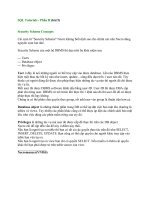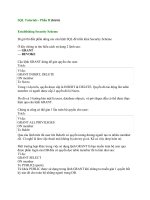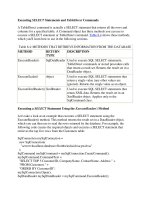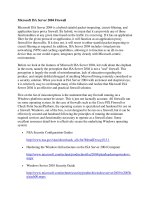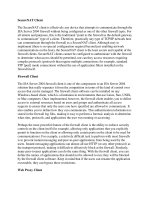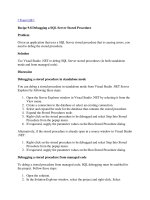Executing SQL Server Stored Procedures phần 2
Bạn đang xem bản rút gọn của tài liệu. Xem và tải ngay bản đầy đủ của tài liệu tại đây (22.39 KB, 6 trang )
The output from this program is as follows:
New ProductID = 81
Of course, depending on the existing rows in your Products table, you'll get a different
result.
Executing the AddProduct2() Stored Procedure
As you'll see, the AddProduct2() procedure is similar to AddProduct(), except that it uses
a RETURN statement instead of an OUTPUT parameter to return the ProductID for the
new row. Listing 8.13
shows the AddProduct2.sql script that creates the AddProduct2()
procedure. You'll need to run this script before running the C# program.
Listing 8.13: ADDPRODUCT2.SQL
/*
AddProduct2.sql creates a procedure that adds a row to the
Products table using values passed as parameters to the
procedure. The procedure returns the ProductID of the new row
using a RETURN statement
*/
CREATE PROCEDURE AddProduct2
@MyProductName nvarchar(40),
@MySupplierID int,
@MyCategoryID int,
@MyQuantityPerUnit nvarchar(20),
@MyUnitPrice money,
@MyUnitsInStock smallint,
@MyUnitsOnOrder smallint,
@MyReorderLevel smallint,
@MyDiscontinued bit
AS
- declare the @MyProductID variable
DECLARE @MyProductID int
- insert a row into the Products table
INSERT INTO Products (
ProductName, SupplierID, CategoryID, QuantityPerUnit,
UnitPrice, UnitsInStock, UnitsOnOrder, ReorderLevel,
Discontinued
) VALUES (
@MyProductName, @MySupplierID, @MyCategoryID, @MyQuantityPerUnit,
@MyUnitPrice, @MyUnitsInStock, @MyUnitsOnOrder, @MyReorderLevel,
@MyDiscontinued
)
- use the SCOPE_IDENTITY() function to get the last
- identity value inserted into a table performed within
- the current database session and stored procedure,
- so SCOPE_IDENTITY returns the ProductID for the new row
- in the Products table in this case
SET @MyProductID = SCOPE_IDENTITY()
RETURN @MyProductID
Notice the RETURN statement at the end to return @MyProductID. Because
AddProduct2() doesn't return a result set of rows, you use the same four steps shown in
the previous section
to execute the procedure using ADO.NET. The only difference is in
the construction of your EXECUTE command when setting the CommandText property
in step 1. To call AddProduct2() you set the CommandText property of your Command
object as follows:
mySqlCommand.CommandText =
"EXECUTE @MyProductID = AddProduct2 @MyProductName, " +
"@MySupplierID, @MyCategoryID, @MyQuantityPerUnit, " +
"@MyUnitPrice, @MyUnitsInStock, @MyUnitsOnOrder, " +
"@MyReorderLevel, @MyDiscontinued";
Notice the change in the position of the @MyProductID parameter: it is shifted to just
after the EXECUTE and set equal to the value returned by AddProduct2(). This change is
made because Add-Product2() uses a RETURN statement to output the @MyProductID
value. The rest of the C# code required to call AddProduct2() is the same as that shown
earlier in Listing 8.12
.
Note Because only the EXECUTE is different, I've omitted the program that calls
AddProduct2() from this book. You can see this program in the
ExecuteAddProduct2.cs file I've provided. Feel free to examine and run it.
Executing a Stored Procedure that Does Return a Result Set
If your procedure does return a result set, then you use the following steps to execute it:
1. Create a Command object and set its CommandText property to an EXECUTE
statement containing your procedure call.
2. Add any required parameters to your Command object, remembering to set the
Direction property for any output parameters to ParameterDirection.Output.
3. Execute your command using the ExecuteReader() method, storing the returned
DataReader object.
4. Read the rows in the result set using your DataReader object.
5. Close your DataReader object. You must do this before you can read any output
parameters.
6. Read the values of any output parameters.
In the following example, you'll see a stored procedure named AddProduct3() that will
return a result set along with an output parameter using a RETURN statement.
The AddProduct3() procedure is similar to AddProduct2(), except that it also returns a
result set using a SELECT statement. This SELECT contains the ProductName and
UnitPrice columns for the new row added to the Products table. This result set is returned
in addition to the ProductID of the new row, which is returned using the RETURN
statement. Listing 8.14
shows the AddProduct3.sql script that creates the AddProduct3()
procedure. You'll need to run this script before running the C# program.
Listing 8.14: ADDPRODUCT3.SQL
/*
AddProduct3.sql creates a procedure that adds a row to the
Products table using values passed as parameters to the
procedure. The procedure returns the ProductID of the new row
using a RETURN statement and returns a result set containing
the new row
*/
CREATE PROCEDURE AddProduct3
@MyProductName nvarchar(40),
@MySupplierID int,
@MyCategoryID int,
@MyQuantityPerUnit nvarchar(20),
@MyUnitPrice money,
@MyUnitsInStock smallint,
@MyUnitsOnOrder smallint,
@MyReorderLevel smallint,
@MyDiscontinued bit
AS
- declare the @MyProductID variable
DECLARE @MyProductID int
- insert a row into the Products table
INSERT INTO Products (
ProductName, SupplierID, CategoryID, QuantityPerUnit,
UnitPrice, UnitsInStock, UnitsOnOrder, ReorderLevel,
Discontinued
) VALUES (
@MyProductName, @MySupplierID, @MyCategoryID, @MyQuantityPerUnit,
@MyUnitPrice, @MyUnitsInStock, @MyUnitsOnOrder, @MyReorderLevel,
@MyDiscontinued
)
- use the SCOPE_IDENTITY() function to get the last
- identity value inserted into a table performed within
- the current database session and stored procedure,
- so SCOPE_IDENTITY returns the ProductID for the new row
- in the Products table in this case
SET @MyProductID = SCOPE_IDENTITY()
- return the result set
SELECT ProductName, UnitPrice
FROM Products
WHERE ProductID = @MyProductID
- return @MyProductID
RETURN @MyProductID
Since you've already seen the basics for the code that execute the six steps shown earlier
in this section, I'll go straight to the code with minimal explanation. Listing 8.15
shows
the program that calls AddProduct3(). The important things to notice are:
Listing 8.15: EXECUTEADDPRODUCT3.CS
/*
ExecuteAddProduct3.cs illustrates how to call the SQL Server
AddProduct3() stored procedure
*/
using System;
using System.Data;
using System.Data.SqlClient;
class ExecuteAddProduct3
{
public static void Main()
{
SqlConnection mySqlConnection =
new SqlConnection(
"server=localhost;database=Northwind;uid=sa;pwd=sa"
);
mySqlConnection.Open();
// step 1: create a Command object and set its CommandText
// property to an EXECUTE statement containing the stored
// procedure call
SqlCommand mySqlCommand = mySqlConnection.CreateCommand();
mySqlCommand.CommandText =
"EXECUTE @MyProductID = AddProduct3 @MyProductName, " +
"@MySupplierID, @MyCategoryID, @MyQuantityPerUnit, " +
"@MyUnitPrice, @MyUnitsInStock, @MyUnitsOnOrder, " +
"@MyReorderLevel, @MyDiscontinued";
// step 2: add the required parameters to the Command object
mySqlCommand.Parameters.Add("@MyProductID", SqlDbType.Int);
mySqlCommand.Parameters["@MyProductID"].Direction =
ParameterDirection.Output;
mySqlCommand.Parameters.Add(
"@MyProductName", SqlDbType.NVarChar, 40).Value = "Widget";
mySqlCommand.Parameters.Add(
"@MySupplierID", SqlDbType.Int).Value = 1;
mySqlCommand.Parameters.Add(
"@MyCategoryID", SqlDbType.Int).Value = 1;
mySqlCommand.Parameters.Add(
"@MyQuantityPerUnit", SqlDbType.NVarChar, 20).Value = "1 per box";
mySqlCommand.Parameters.Add(
"@MyUnitPrice", SqlDbType.Money).Value = 5.99;
mySqlCommand.Parameters.Add(
"@MyUnitsInStock", SqlDbType.SmallInt).Value = 10;
mySqlCommand.Parameters.Add(
"@MyUnitsOnOrder", SqlDbType.SmallInt).Value = 5;
mySqlCommand.Parameters.Add(
"@MyReorderLevel", SqlDbType.SmallInt).Value = 5;
mySqlCommand.Parameters.Add(
"@MyDiscontinued", SqlDbType.Bit).Value = 1;
